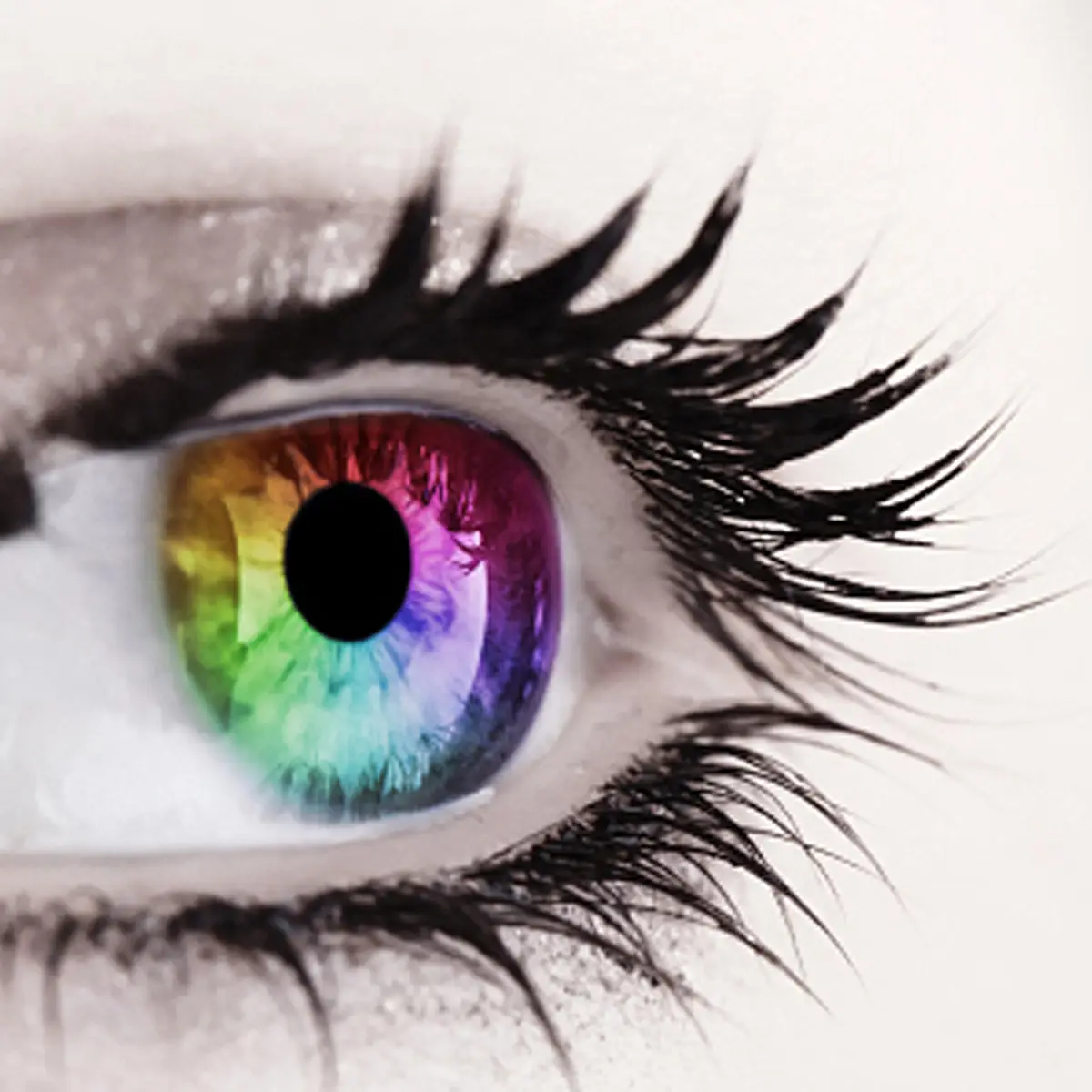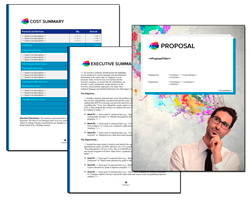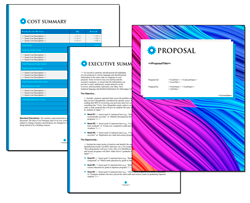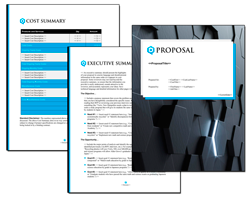
The Ultimate Guide on How to Write a Graphic Designer Proposal That Wins Clients
Need to create a graphic designer proposal but looking for help figuring out where to start? This article will guide you on how to write a graphic design services proposal that communicates your expertise and fits your client's brief. Prepare to create a proposal that reflects your design capabilities and is primed for success.
Key Takeaways
- A successful graphic design proposal must demonstrate an understanding of the client's business, brand, industry, target audience, and specific challenges to create unique, tailored solutions.
- Your proposal should be compelling and well-structured, including an engaging executive summary, a clear outline of project scope and goals, a showcase of relevant portfolio work, testimonials, pricing details, and payment terms.
- To protect the designer's and client's interests, the proposal must include legal elements such as intellectual property rights, termination clauses, kill fees, and a transparent contract. The proposal or a separate graphic design services contract may include your contract terms.
Understanding Your Client's Needs

Understanding your client's needs is critical for any successful graphic design proposal. After all, prospective clients are more likely to choose a designer who understands their business, brand, and unique challenges. The more you know about your clients, their industry, and their target audience, the better you can tailor your proposal to resonate with them.
Businesses are inundated with generic pitches, and a proposal that addresses the client's needs and problems stands out. To create a standout proposal, follow these steps:
- Do your homework and engage with the client to comprehend their unique business context and expectations.
- Research their industry, audience, and competitors to understand their needs better.
- Conduct interviews or discovery sessions to understand their design needs and preferences.
Following these steps, you can create a proposal tailored to the client's needs and stand out.
Research the Client's Business
Understanding your client's business is fundamental to creating a proposal that hits the mark. Begin by researching their current visual branding, which includes:
- Imagery
- Color schemes
- Typography
- Overall design style

This will give you a sense of their brand identity and help you tailor your proposal to align with it, using related projects as a reference.
But don't stop there. Conduct a thorough analysis of the client's industry. Identify key trends, challenges, and opportunities that could influence the design direction. Look at competitors' branding to identify ways to differentiate your client's brand. This will inform your design approach and demonstrate your commitment to adding value to the client's business.
A combination of online research and direct communication with the prospective client will help you better understand their specific needs and preferences, facilitating the customization of the proposal.
Identify the Target Audience
Understanding the client's target audience is another crucial aspect of tailoring your proposal. The design direction you propose should resonate with the audience segment your client is trying to reach, as this is vital to the success of their business. Keep in mind that different projects require different types of proposals. For instance, a proposal for a logo design for a startup would differ significantly from a proposal for a website redesign for a well-established corporation.
Here are a few examples of design projects that a graphic design company typically submits proposals for, showcasing their graphic design services:
- Logo Design: Creating unique corporate logos to establish brand identity.
- Brand Guidelines: Developing comprehensive brand books that detail the correct usage of logos, colors, typography, and other visual elements.
- Website Design: Designing websites' layout, style, and interfaces to enhance user experience and aesthetic appeal.
- Mobile App Design: Creating the visual and interactive elements of mobile applications.
- Advertising Materials: Producing graphics for digital and print ads, including banners, posters, and billboards.
- Social Media Graphics: Creating visually engaging content for platforms like Instagram, Facebook, Twitter, and LinkedIn.
- Brochures and Flyers: Designing informational or promotional brochures and flyers.
- Business Cards: Designing professional business cards.
- Packaging Design: Creating the packaging for products that involve both aesthetic appeal and functional design.
- Email Marketing Templates: Designing email layouts that are both visually appealing and optimized for various devices.
- Infographics: Developing visually engaging and informative infographics that simplify complex information.
- Presentation Design: Creating templates and visuals for business or educational presentations.
- Publication Design: Working on the layout and visual elements of books, magazines, and other publications.
- Event Invitations: Designing invitations for corporate events, weddings, and other functions.
- Vehicle Wraps: Creating graphic wraps for cars, trucks, and other vehicles.
- Trade Show Displays: Designing booths and other display graphics for trade shows and exhibitions.
- Animated Graphics: Producing animations for digital platforms, which may include GIFs or motion graphics.
- Video Graphics: Creating graphics and visual effects for video productions.
- Merchandise Design: Designing graphics for merchandise such as t-shirts, hats, and mugs.
- Signage and Wayfinding Systems: Creating signs and visual cues for navigation within public and private spaces.
Creating a Winning Graphic Design Proposal

Creating your winning graphic design proposal involves more than just presenting your skills and portfolio; it's about telling a persuasive story that demonstrates the impact of your work and the added value you provide. Here are the key elements to include in your proposal:
- Engaging executive summary: Outline the scope of work, provide pricing details, and set the stage for the rest of the proposal.
- Portfolio Showcase: Include examples of your previous work to showcase your skills and expertise.
- Project scope and goals: Clearly outline the scope of the project and the goals you aim to achieve.
- Pricing and payment terms: Provide detailed pricing information and clearly state your payment terms.
By including these elements in your proposal, you can effectively communicate your value and increase your chances of winning the project.
A well-written proposal is not just about the content but also its presentation. Using a graphic design proposal template or a design project proposal template can help you create a professional and compelling proposal more efficiently. It offers pre-written content, beautiful images, and pricing tables that you can customize to fit your prospective client's needs. Additionally, Proposal Kit software and its customizable templates give you a structured format to make preparing professional-looking proposals more efficient.
Graphic designers will not want to use premade stock graphic designs, so using customizable templates that allow the designer to swap out stock logos and images with their own is essential when using a templated system. Proposal Kit's system enables designers to customize stock design themes and create custom branded themes.
Start with an Engaging Executive Summary

The executive summary sets the tone for the rest of the proposal. It is a graphic design brief highlighting key points, the expected design solution, and its business impact. Since it's the first thing prospective clients will read, it must be engaging enough to convince them to continue reading the rest of your proposal.
In the executive summary, address the client's main issues and back up your points with specific data. This emphasizes your understanding and seriousness about the project's needs. Include and substantiate a clear solution strategy with complex data to demonstrate how the design will impact the client's business. And remember, while the executive summary comes first, it's often best to write it last. This ensures that all key highlights are introduced to the client, setting a persuasive tone for the rest of the proposal.
Showcase Your Design Portfolio
Your portfolio is the proof you can deliver. Including relevant samples and case studies in your proposal is crucial to demonstrating your skills and expertise. It directly influences a potential client's confidence in your capabilities. Showcase your previous work, especially those with diverse deliverables. This illustrates your ability to handle various projects and highlights your adaptability and breadth of experience.
In addition to showcasing your work, include testimonials from past clients. These serve to enhance your credibility and form a basis of trust. Testimonials also showcase client satisfaction and the successful application of your skills. Your portfolio is not just a collection of your work but a testament to your ability to deliver results that meet and exceed client expectations.
Structuring Your Graphic Design Proposal
The structure of your proposal is as important as the content within it. A well-structured proposal ensures clarity and helps prevent misunderstandings. It should include essential sections such as:
- Executive summary
- Background information
- Objectives
- Project scope
- Timeline
- Price
- Terms and conditions

The solution section must clearly explain the plan and its benefits for the client. To prevent scope creep, the deliverables section should describe what the client will receive upon project completion, such as design files, source files, and a style guide.
A good structure makes your proposal easy to read and understand and helps your clients find the necessary information. This contributes to a positive user experience and leaves a good impression on prospective clients, providing them with a well-written solution.
Project Scope and Goals
Outlining the project scope and goals is crucial to structuring your proposal. This helps prevent scope creep, a common problem where projects expand beyond their original objectives and ensures that both parties agree on the expected deliverables. A clear project scope includes a summary of the services based on the initial consultation with the client.
The project's completion date is essential to the timeline and should be clearly specified in the proposal's executive summary. In graphic design, clear milestones and deadlines for each project phase are necessary. Doing so promotes timely delivery and ensures an organized, creative process. Additionally, client responsibilities should be distinctly listed in the contract.
Pricing and Payment Terms
Transparency in pricing can help build trust with your clients. A comprehensive yet concise breakdown of costs in your proposal prevents misunderstandings and helps clients understand the value they receive from investments in your design services. Your proposal and contract should state the following:
- Terms of payment, including retainer, deposit, and due dates for payment
- Accepted forms of compensation
- Invoicing details
- Payment methods
This ensures agreement and timely transactions.
Freelance graphic designers' rates are influenced by:
- Their level of design experience
- Project complexity
- Profit margin expectations
- Ownership rights granted (full rights typically commanding a premium rate)
Discussing and aligning the client's budget with your pricing from the outset ensures the project is financially viable and contributes to better cash flow and business growth for you.
Revision and Approval Process

Outlining the revision and approval process is an essential part of your proposal. It sets clear expectations for both parties and fosters timely project completion. The design process should show the journey from initial concepts to final designs, including project milestones, timelines, and estimated completion dates. Offering up to three rounds of revisions is standard practice, and clients should be aware of what to expect after each stage of revisions.
The client approval process must also be clearly defined, indicating the point of contact in the client's team and, if applicable, identifying the final decision-maker in larger organizations. This helps ensure smooth communication and an efficient review process.
Tips for Creating a Winning Graphic Designer Proposal
Creating a winning proposal takes more than just ticking off the boxes. Creating a well-thought-out proposal that distinguishes you from competitors requires a dedicated effort. Here are some tips to help you create a proposal that will win over clients:
- Personalize your proposal to the client's needs.
- Use visuals to enhance your proposal.
- Include testimonials and success metrics.
Transparency is vital in your proposal to justify your pricing and reduce uncertainty for the client. It's also essential to include a compelling call to action to encourage the client to accept the proposal and commence the project. Your proposal is not just a document; it reflects your professionalism, creativity, and commitment to delivering value to your client.
Personalize Your Proposal
A personalized proposal can make all the difference in winning a client. It communicates how your services can address clients' needs and unique problems. It shows that you've put in the time and effort to understand their needs, which helps build trust and differentiate you from competitors.
Within the proposal, demonstrate your understanding of the client's problem. This shows that you've done your homework and are serious about the project. Communication is critical here. Keep open lines of communication with the client to ensure that your proposal aligns with their expectations and goals.
Use Visuals to Enhance Your Proposal
Since you're a graphic designer, your proposal should reflect your creativity and design skills. Incorporating various types of visuals such as:
- Charts
- Graphs
- Diagrams
- Images
- Videos
Make your proposal more engaging and memorable. However, remember that visuals must complement the textual content, not dominate it.
The visual elements of a style guide, including color palettes and typography, should prioritize simplicity and readability. Ensure they align with the brand's identity for clear communication. After all, your proposal is not just a document; it reflects your design philosophy and attention to detail.
Here are some related samples included in every downloadable Proposal Pack
- CD-ROM Marketing Materials Creation Proposal
- Corporate Identity Creation Proposal
- Company Rebranding Sample Proposal
- Marketing Campaign Services Sample Proposal
- Advertising Campaign Services Sample Proposal
- Website Advertising Offer Sample Proposal
- Graphic Designer Sample Proposal
- Printing and Signage Services Sample Proposal
Here are some related downloadable templates
Include Testimonials and Success Metrics
Testimonials and success metrics play a pivotal role in establishing credibility and demonstrating the impact of your work. Client testimonials enhance your credibility and form a basis of trust. They attest to the quality of your artistry and the success of meeting other clients' needs.
Success metrics provide tangible evidence of your design's impact. They aid clients in evaluating the effectiveness of your proposed design solutions. When potential clients see your work's impact on your past clients' businesses, they're more likely to trust that you can do the same for them.
Legal Considerations and Contracts
While it's essential to focus on the creative aspects of your proposal, you also need to consider legal aspects. A design proposal is a legal record to reference in disputes, protecting your and the client's interests. A signed graphic design contract indicates mutual consent and provides legal recourse if a client refuses to pay, establishing a professional framework for the relationship. Typically, a contract is signed after a proposal is accepted; however, terms and conditions can sometimes be part of the proposal document. Consult your attorney about the approach best for you and the laws of your state or country so you understand if any parts of your proposal are considered legally binding vs. what is in the contract.
The proposal must clearly articulate:
- Intellectual property rights and limitations of liability to prevent copyright infringement issues and clarify the extent of your responsibility
- Payment terms
- Project timelines
- Work expectations
This is done to ensure both parties are aligned and protected.
Intellectual Property Rights
Intellectual property rights are crucial in design proposals, as they clarify the ownership and use of the designs created. These should cover:
- Ownership rights
- Client access
- Changes
- Usage in your portfolio
- Rights to stock images and typography
Clear articulation of intellectual property rights ensures that you and the client are on the same page about who owns the artwork and how it can be used. This prevents future disputes and provides a smooth working relationship with your client.
 Proposal Kit Professional provides the most content, including legal contracts and a free design theme pack. Plus, advanced software features include custom branding and customizable quoting databases.
Proposal Kit Professional provides the most content, including legal contracts and a free design theme pack. Plus, advanced software features include custom branding and customizable quoting databases. Proposal Pack for Any Business covers this type of proposal and includes samples. There are also some commonly used specialty design themes available:
Proposal Pack for Any Business covers this type of proposal and includes samples. There are also some commonly used specialty design themes available:Photo Design Proposal Packs
Line Art Design Proposal Packs
Termination Clauses and Kill Fees

Termination clauses and kill fees are another essential aspect to include in your proposal. They protect both parties in case of project cancellation and compensate you for your time and resources. Your proposal should clearly outline a termination notice period to mitigate sudden project cancellations and give both parties predictable timelines for concluding outstanding matters.
Kill fees are predetermined fees that a client might have to pay if the project is canceled before completion. They compensate you for the time and resources invested in the project. The proposal should specify how expenses incurred up to the point of cancellation will be handled. It should also include a provision for partial delivery of work if a project is terminated midway so the client knows what to expect.
Summary
Creating a winning graphic design proposal goes beyond showcasing your skills and portfolio. It involves understanding your client's unique needs, demonstrating your ability to solve their problems, and convincing them that you're the right person for the job. A well-written proposal is personalized, visually appealing, and includes testimonials and success metrics. It also addresses legal considerations and contracts, setting clear expectations for both parties. Writing such a proposal may require time and effort, but it's an investment that can significantly increase your chances of winning clients.
Frequently Asked Questions
What should be included in a graphic design proposal?
Your graphic design proposal should include an engaging executive summary, a showcase of your design portfolio, a clear project scope and goals, detailed pricing and payment terms, testimonials and success metrics, and legal considerations and contracts. This will ensure a comprehensive and professional presentation of your services.
How can I personalize my proposal?
To personalize your proposal, research the client's business, brand, and target audience to understand and address their specific needs and unique problems. This will help you tailor your proposal accordingly. Proposal Kit's Wizard software will automatically add client-specific data throughout your proposal to give a more personalized presentation.
What is the importance of a well-structured proposal?
A well-structured proposal is essential as it ensures clarity and helps prevent misunderstandings. It also makes the proposal easy to read and understand, which benefits clients.
What are the legal considerations to include in a proposal?
Include legal considerations like intellectual property rights, limitations of liability, and termination clauses in your contract or proposal to protect both parties' interests and prevent future disputes.
How should I price my design services?
You should price your design services transparently, ensuring that the value clients receive justifies your pricing. Aligning the client's budget with your pricing from the beginning is crucial to ensuring financial viability. Your pricing will depend on various factors, including your expertise, the value you bring to a project, and your overhead costs.
Where do I get a graphic design proposal and contract?
The Proposal Kit Professional bundle includes contracts and proposals for graphic designers and related documents for similar projects.



 Cart
Cart
 Are you just looking for a template, sample, or software for your graphic design proposals? Click these links to skip down the page and get right to it.
Are you just looking for a template, sample, or software for your graphic design proposals? Click these links to skip down the page and get right to it.











 Facebook
Facebook YouTube
YouTube X
X Search Site
Search Site